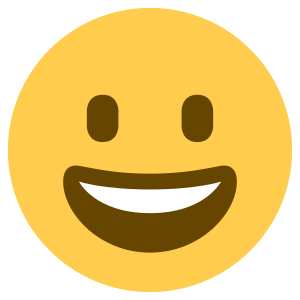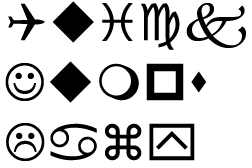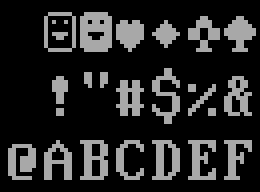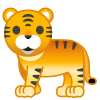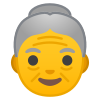Emoji facts for kids
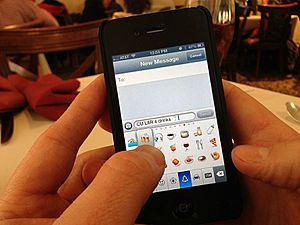
An emoji (pronounced i-MOH-jee) is a small picture or symbol used in text messages and on websites. Think of them as tiny images that help you show feelings or ideas when you're typing. They are like emoticons (like :-) or :-( ), but emojis are actual pictures, not just keyboard symbols. The word "emoji" comes from Japanese words: e (meaning 'picture') and moji (meaning 'character'). It sounds like "emotion," but that's just a coincidence!
Emojis first appeared on Japanese mobile phones in 1997. They became super popular around the world in the 2010s when they were added to many phone systems. Now, emojis are a big part of how people communicate everywhere. In 2015, the "Face with Tears of Joy" emoji (😂) was even named the "word of the year" by Oxford Dictionaries!
The Story of Emojis
From Emoticons to Emojis (1990s)
Before emojis, there were emoticons. In 1982, a computer scientist named Scott Fahlman suggested using symbols like :-) for a smile and :-( for a frown in online messages. This helped people show their feelings in text.
Later, in the 1990s, companies in Japan, America, and Europe started to develop these ideas further. In 1990, Microsoft released a font called Wingdings. It let people send small pictures, like smiling faces, in messages. But these only worked if the other person also had the Wingdings font.
In 1997, a Japanese phone company called J-Phone launched a phone with 90 different emojis. These were simple, black-and-white pictures, 12 by 12 pixels big. They showed things like numbers, sports, and even the Pile of Poo emoji! However, this phone didn't sell well, so these early emojis weren't widely used.
Then, in 1999, Shigetaka Kurita created 176 emojis for NTT DoCoMo's i-mode mobile platform in Japan. He wanted to make online conversations easier and more fun. Kurita got his ideas from Japanese manga comics, where characters often have small symbols to show feelings (like a sweat drop for nervousness). He also looked at weather symbols and Chinese characters. His emojis were colorful and included many everyday objects, sports, and weather symbols. His work is now shown in the Museum of Modern Art in New York City.
Making Emoji Sets Better (2000–2007)
The small, 12-by-12-pixel emojis became very popular in Japan. This was helped by the success of DoCoMo's i-mode service, which was an early form of a smartphone. By 2004, i-mode had 40 million users, meaning lots of people were using emojis for the first time. Other phone companies in Japan started offering their own emoji sets too. But the problem was that these different companies didn't work together, so emojis often looked different or didn't work between different phones.
Around this time, a system called Unicode was already the international standard for text. Unicode started adding some characters that would later be called emojis, like symbols from older computer systems. For example, Unicode 4.0 (in the 2000s) added 16 new emojis, including arrows and a warning triangle.
In 1999, Nicolas Loufrani created "The Smiley Dictionary," which had hundreds of smileys. This allowed people to add smileys to emails and messages on their computers. By 2003, it had grown to include many more. This "smiley toolbar" became very popular on platforms like MSN Messenger. People could even add their own custom emoticons. Companies like MSN Messenger and BlackBerry saw how popular these were and started offering their own official sets of emoticons, which were like early emojis.
Emojis Go Global with Unicode (2007–2014)
In 2007, Google became the first American company to seriously push for emojis. A team from Google, including Mark Davis, started asking the Unicode organization to make emojis a worldwide standard. Unicode had not thought emojis were important before, but they changed their minds.
In 2009, Google and Apple Inc. worked together to propose 625 new emoji characters to Unicode. Unicode accepted this idea in 2010. Before this, Google and Apple used their own special ways to show emojis on their devices. Google added emojis to Gmail in 2008, and Apple added them to iPhone OS in November 2008. At first, Apple's emojis were only for users in Japan.
But iPhone users outside Japan soon found a way to get the emoji keyboard by downloading Japanese apps. This created a lot of demand. In 2010, an app called "Emoji" was created by Josh Gare that let iPhone users outside Japan easily turn on the emoji keyboard.
By 2009, many countries agreed on a standard set of 722 emojis. These were officially released in October 2010 as part of Unicode 6.0. Apple then made the emoji keyboard available to everyone in iOS 5.0 in 2011. Later, in 2014, Unicode 7.0 added about 250 more emojis, including many from the Webdings and Wingdings fonts.
These early Unicode emojis came from different places. Sometimes, the same emoji existed in different old systems, and Unicode combined them. For example, the "rain" emoji (☔️) from Japanese phones was combined with an existing umbrella symbol.
Modern Emojis (2015–Present)
In 2015, Unicode released "Emoji 1.0," which was a big step. This version introduced a way to add different skin tones to human emojis. It also gave official rules for which Unicode characters should be considered emojis and how they should look.
Since then, new emojis are added regularly to the Unicode standard. This is because people all over the world want emojis that represent their cultures and interests. Some emojis we use today even came from older messaging systems like Yahoo Messenger and MSN Messenger.
The popularity of emojis has also pushed companies to improve how they handle Unicode characters. This has helped not only emojis but also support for less common languages and historical writing systems in software.
How Emojis Work in Language
Emojis are like a special language that helps us show feelings in messages. They are often used to make messages more positive. Emojis don't usually have their own meaning, but they add extra meaning to the words you type. They can make your text clearer and more believable.
How people use emojis can depend on who they are and where they are. Studies show that women tend to use emojis more than men, but men use a wider variety of emojis. People who are more outgoing and friendly often use more emojis. Also, emoji use can be different in various cultures around the world.
Emoji Problems: Misunderstandings
Sometimes, emojis can cause confusion. This can happen for two main reasons:
- The person receiving the emoji understands it differently than the sender.
- The emoji looks different on the sender's device compared to the receiver's device.
The first problem is about how people interpret emojis. When you send an emoji, you have a certain meaning in mind. But the person who gets it might see it differently because of their own culture or how they feel. For example, in China, a simple smiley face can sometimes be used to show a mocking or annoyed attitude, because of how the face muscles are drawn on that specific emoji.
The second problem is about technology. When you pick an emoji, your phone sends it as a special code. If the sender and receiver use different phones or apps, the emoji might look different on each screen. Even small changes in how an emoji looks can completely change its meaning. For example, in 2020, actress Jameela Jamil sent a "Face with Hand Over Mouth" emoji (🤭) from her iPhone. On Apple devices, it looks thoughtful, but on other phones, it looks like a giggling face. Many people thought she was laughing at something serious, but that wasn't her intention at all!
Researchers have found that while emojis can replace words easily (like a rose emoji instead of the word "rose"), it takes people about 50% longer to understand a message with an emoji compared to just text.
Emoji Differences Across Platforms
Emoji characters can look a bit different depending on the phone or computer you're using. Companies try to make their emojis unique. For example, the calendar emoji on Apple products always shows July 17. This is because Apple announced its iCal calendar app on that date in 2002. This led some Apple users to call July 17 "World Emoji Day"! Other emoji fonts show different dates or no date at all.
How Emojis Are Built
Early Emojis in Japan
In Japan, different mobile companies used their own special codes for emojis, which meant they often weren't compatible. For example, the code for a convenience store (🏪) on SoftBank phones was used for a wristwatch (⌚️) on KDDI phones! This made it hard for people on different networks to send emojis to each other.
Unicode Makes Emojis Work Everywhere
Most emojis are part of a special section of Unicode called the Supplementary Multilingual Plane (SMP). Older computer systems were sometimes only designed to handle basic characters, not these newer, more complex ones.
When Unicode added emojis, it pushed companies to improve their support for all kinds of characters. This was great because it also helped support for minority languages and historical writing systems that use these more complex characters.
Adding Color to Emojis
To see colorful emojis, your operating system needs to support "color fonts." Not all systems do, so sometimes emojis might appear as black-and-white outlines or not at all. This means that font makers often have to create emojis in several different formats to make sure they work on various phones and computers.
Emojis on Different Devices
- Apple: Apple added emojis to its desktop computers (OS X 10.7 Lion) in 2011. Users can see and create emojis in most apps. The emoji keyboard was first available in Japan in 2008 and then worldwide in iOS 5.0 in 2011. Apple says the "face with tears of joy" is the most popular emoji among English speakers in America, followed by the "heart" emoji.
- Windows: Windows 7 got some black-and-white emojis, and Windows 8.1 added full-color ones. You can access them through an onscreen keyboard or a keyboard shortcut.
- Firefox: In 2016, Firefox browser added its own emoji display for computers that didn't have built-in emoji support.
- Facebook and Twitter: These websites often replace standard Unicode emojis with their own custom emoji designs. This means an emoji you send might look slightly different on Facebook or Twitter compared to how it looks on your phone's keyboard.
Changing Emojis: Modifiers
Emoji vs. Text Style
Unicode has ways to tell a computer if an emoji should look like a colorful picture or a simple black-and-white text symbol. You can add a special code after an emoji to tell it to show as a text symbol or as a colorful emoji.
Skin Color Options
In 2015, Unicode 8.0 added five special characters that let you change the skin tone of human emojis. These are based on the Fitzpatrick scale, which is used to classify human skin colors. If a human emoji doesn't have one of these skin tone modifiers, it should appear in a general, non-realistic color like bright yellow, blue, or gray.
The table below shows how these skin tone modifiers work:
Emojis in Unicode
As of As of 2022[update], Unicode has 3,664 emojis! These emojis are found in different sections (called "blocks") of the Unicode system. For example, many are in the Miscellaneous Symbols and Pictographs block. Some special ones, like flag emojis, are made by combining two other symbols.
| 0 | 1 | 2 | 3 | 4 | 5 | 6 | 7 | 8 | 9 | A | B | C | D | E | F | |
| U+00Ax | ©️ | ®️ | ||||||||||||||
| U+203x | ‼️ | |||||||||||||||
| U+204x | ⁉️ | |||||||||||||||
| U+212x | ™️ | |||||||||||||||
| U+213x | ℹ️ | |||||||||||||||
| U+219x | ↔️ | ↕️ | ↖️ | ↗️ | ↘️ | ↙️ | ||||||||||
| U+21Ax | ↩️ | ↪️ | ||||||||||||||
| U+231x | ⌚️ | ⌛️ | ||||||||||||||
| U+232x | ⌨️ | |||||||||||||||
| U+23Cx | ⏏️ | |||||||||||||||
| U+23Ex | ⏩️ | ⏪️ | ⏫️ | ⏬️ | ⏭️ | ⏮️ | ⏯️ | |||||||||
| U+23Fx | ⏰️ | ⏱️ | ⏲️ | ⏳️ | ⏸️ | ⏹️ | ⏺️ | |||||||||
| U+24Cx | Ⓜ️ | |||||||||||||||
| U+25Ax | ▪️ | ▫️ | ||||||||||||||
| U+25Bx | ▶️ | |||||||||||||||
| U+25Cx | ◀️ | |||||||||||||||
| U+25Fx | ◻️ | ◼️ | ◽️ | ◾️ | ||||||||||||
| U+260x | ☀️ | ☁️ | ☂️ | ☃️ | ☄️ | ☎️ | ||||||||||
| U+261x | ☑️ | ☔️ | ☕️ | ☘️ | ☝️ | |||||||||||
| U+262x | ☠️ | ☢️ | ☣️ | ☦️ | ☪️ | ☮️ | ☯️ | |||||||||
| U+263x | ☸️ | ☹️ | ☺️ | |||||||||||||
| U+264x | ♀️ | ♂️ | ♈️ | ♉️ | ♊️ | ♋️ | ♌️ | ♍️ | ♎️ | ♏️ | ||||||
| U+265x | ♐️ | ♑️ | ♒️ | ♓️ | ♟️ | |||||||||||
| U+266x | ♠️ | ♣️ | ♥️ | ♦️ | ♨️ | |||||||||||
| U+267x | ♻️ | ♾️ | ♿️ | |||||||||||||
| U+269x | ⚒️ | ⚓️ | ⚔️ | ⚕️ | ⚖️ | ⚗️ | ⚙️ | ⚛️ | ⚜️ | |||||||
| U+26Ax | ⚠️ | ⚡️ | ⚧️ | ⚪️ | ⚫️ | |||||||||||
| U+26Bx | ⚰️ | ⚱️ | ⚽️ | ⚾️ | ||||||||||||
| U+26Cx | ⛄️ | ⛅️ | ⛈️ | ⛎️ | ⛏️ | |||||||||||
| U+26Dx | ⛑️ | ⛓️ | ⛔️ | |||||||||||||
| 0 | 1 | 2 | 3 | 4 | 5 | 6 | 7 | 8 | 9 | A | B | C | D | E | F | |
| U+26Ex | ⛩️ | ⛪️ | ||||||||||||||
| U+26Fx | ⛰️ | ⛱️ | ⛲️ | ⛳️ | ⛴️ | ⛵️ | ⛷️ | ⛸️ | ⛹️ | ⛺️ | ⛽️ | |||||
| U+270x | ✂️ | ✅️ | ✈️ | ✉️ | ✊️ | ✋️ | ✌️ | ✍️ | ✏️ | |||||||
| U+271x | ✒️ | ✔️ | ✖️ | ✝️ | ||||||||||||
| U+272x | ✡️ | ✨️ | ||||||||||||||
| U+273x | ✳️ | ✴️ | ||||||||||||||
| U+274x | ❄️ | ❇️ | ❌️ | ❎️ | ||||||||||||
| U+275x | ❓️ | ❔️ | ❕️ | ❗️ | ||||||||||||
| U+276x | ❣️ | ❤️ | ||||||||||||||
| U+279x | ➕️ | ➖️ | ➗️ | |||||||||||||
| U+27Ax | ➡️ | |||||||||||||||
| U+27Bx | ➰️ | ➿️ | ||||||||||||||
| U+293x | ⤴️ | ⤵️ | ||||||||||||||
| U+2B0x | ⬅️ | ⬆️ | ⬇️ | |||||||||||||
| U+2B1x | ⬛️ | ⬜️ | ||||||||||||||
| U+2B5x | ⭐️ | ⭕️ | ||||||||||||||
| U+303x | 〰️ | 〽️ | ||||||||||||||
| U+329x | ㊗️ | ㊙️ | ||||||||||||||
| U+1F00x | 🀄 | |||||||||||||||
| U+1F0Cx | 🃏 | |||||||||||||||
| U+1F17x | 🅰️ | 🅱️ | 🅾️ | 🅿️ | ||||||||||||
| U+1F18x | 🆎 | |||||||||||||||
| U+1F19x | 🆑 | 🆒 | 🆓 | 🆔 | 🆕 | 🆖 | 🆗 | 🆘 | 🆙 | 🆚 | ||||||
| U+1F20x | 🈁 | 🈂️ | ||||||||||||||
| U+1F21x | 🈚 | |||||||||||||||
| U+1F22x | 🈯 | |||||||||||||||
| U+1F23x | 🈲 | 🈳 | 🈴 | 🈵 | 🈶 | 🈷️ | 🈸 | 🈹 | 🈺 | |||||||
| U+1F25x | 🉐 | 🉑 | ||||||||||||||
| U+1F30x | 🌀 | 🌁 | 🌂 | 🌃 | 🌄 | 🌅 | 🌆 | 🌇 | 🌈 | 🌉 | 🌊 | 🌋 | 🌌 | 🌍 | 🌎 | 🌏 |
| U+1F31x | 🌐 | 🌑 | 🌒 | 🌓 | 🌔 | 🌕 | 🌖 | 🌗 | 🌘 | 🌙 | 🌚 | 🌛 | 🌜 | 🌝 | 🌞 | 🌟 |
| 0 | 1 | 2 | 3 | 4 | 5 | 6 | 7 | 8 | 9 | A | B | C | D | E | F | |
| U+1F32x | 🌠 | 🌡️ | 🌤️ | 🌥️ | 🌦️ | 🌧️ | 🌨️ | 🌩️ | 🌪️ | 🌫️ | 🌬️ | 🌭 | 🌮 | 🌯 | ||
| U+1F33x | 🌰 | 🌱 | 🌲 | 🌳 | 🌴 | 🌵 | 🌶️ | 🌷 | 🌸 | 🌹 | 🌺 | 🌻 | 🌼 | 🌽 | 🌾 | 🌿 |
| U+1F34x | 🍀 | 🍁 | 🍂 | 🍃 | 🍄 | 🍅 | 🍆 | 🍇 | 🍈 | 🍉 | 🍊 | 🍋 | 🍌 | 🍍 | 🍎 | 🍏 |
| U+1F35x | 🍐 | 🍑 | 🍒 | 🍓 | 🍔 | 🍕 | 🍖 | 🍗 | 🍘 | 🍙 | 🍚 | 🍛 | 🍜 | 🍝 | 🍞 | 🍟 |
| U+1F36x | 🍠 | 🍡 | 🍢 | 🍣 | 🍤 | 🍥 | 🍦 | 🍧 | 🍨 | 🍩 | 🍪 | 🍫 | 🍬 | 🍭 | 🍮 | 🍯 |
| U+1F37x | 🍰 | 🍱 | 🍲 | 🍳 | 🍴 | 🍵 | 🍶 | 🍷 | 🍸 | 🍹 | 🍺 | 🍻 | 🍼 | 🍽️ | 🍾 | 🍿 |
| U+1F38x | 🎀 | 🎁 | 🎂 | 🎃 | 🎄 | 🎅 | 🎆 | 🎇 | 🎈 | 🎉 | 🎊 | 🎋 | 🎌 | 🎍 | 🎎 | 🎏 |
| U+1F39x | 🎐 | 🎑 | 🎒 | 🎓 | 🎖️ | 🎗️ | 🎙️ | 🎚️ | 🎛️ | 🎞️ | 🎟️ | |||||
| U+1F3Ax | 🎠 | 🎡 | 🎢 | 🎣 | 🎤 | 🎥 | 🎦 | 🎧 | 🎨 | 🎩 | 🎪 | 🎫 | 🎬 | 🎭 | 🎮 | 🎯 |
| U+1F3Bx | 🎰 | 🎱 | 🎲 | 🎳 | 🎴 | 🎵 | 🎶 | 🎷 | 🎸 | 🎹 | 🎺 | 🎻 | 🎼 | 🎽 | 🎾 | 🎿 |
| U+1F3Cx | 🏀 | 🏁 | 🏂 | 🏃 | 🏄 | 🏅 | 🏆 | 🏇 | 🏈 | 🏉 | 🏊 | 🏋️ | 🏌️ | 🏍️ | 🏎️ | 🏏 |
| U+1F3Dx | 🏐 | 🏑 | 🏒 | 🏓 | 🏔️ | 🏕️ | 🏖️ | 🏗️ | 🏘️ | 🏙️ | 🏚️ | 🏛️ | 🏜️ | 🏝️ | 🏞️ | 🏟️ |
| U+1F3Ex | 🏠 | 🏡 | 🏢 | 🏣 | 🏤 | 🏥 | 🏦 | 🏧 | 🏨 | 🏩 | 🏪 | 🏫 | 🏬 | 🏭 | 🏮 | 🏯 |
| U+1F3Fx | 🏰 | 🏳️ | 🏴 | 🏵️ | 🏷️ | 🏸 | 🏹 | 🏺 | 🏻 | 🏼 | 🏽 | 🏾 | 🏿 | |||
| U+1F40x | 🐀 | 🐁 | 🐂 | 🐃 | 🐄 | 🐅 | 🐆 | 🐇 | 🐈 | 🐉 | 🐊 | 🐋 | 🐌 | 🐍 | 🐎 | 🐏 |
| U+1F41x | 🐐 | 🐑 | 🐒 | 🐓 | 🐔 | 🐕 | 🐖 | 🐗 | 🐘 | 🐙 | 🐚 | 🐛 | 🐜 | 🐝 | 🐞 | 🐟 |
| U+1F42x | 🐠 | 🐡 | 🐢 | 🐣 | 🐤 | 🐥 | 🐦 | 🐧 | 🐨 | 🐩 | 🐪 | 🐫 | 🐬 | 🐭 | 🐮 | 🐯 |
| U+1F43x | 🐰 | 🐱 | 🐲 | 🐳 | 🐴 | 🐵 | 🐶 | 🐷 | 🐸 | 🐹 | 🐺 | 🐻 | 🐼 | 🐽 | 🐾 | 🐿️ |
| U+1F44x | 👀 | 👁️ | 👂 | 👃 | 👄 | 👅 | 👆 | 👇 | 👈 | 👉 | 👊 | 👋 | 👌 | 👍 | 👎 | 👏 |
| U+1F45x | 👐 | 👑 | 👒 | 👓 | 👔 | 👕 | 👖 | 👗 | 👘 | 👙 | 👚 | 👛 | 👜 | 👝 | 👞 | 👟 |
| U+1F46x | 👠 | 👡 | 👢 | 👣 | 👤 | 👥 | 👦 | 👧 | 👨 | 👩 | 👪 | 👫 | 👬 | 👭 | 👮 | 👯 |
| U+1F47x | 👰 | 👱 | 👲 | 👳 | 👴 | 👵 | 👶 | 👷 | 👸 | 👹 | 👺 | 👻 | 👼 | 👽 | 👾 | 👿 |
| U+1F48x | 💀 | 💁 | 💂 | 💃 | 💄 | 💅 | 💆 | 💇 | 💈 | 💉 | 💊 | 💋 | 💌 | 💍 | 💎 | 💏 |
| U+1F49x | 💐 | 💑 | 💒 | 💓 | 💔 | 💕 | 💖 | 💗 | 💘 | 💙 | 💚 | 💛 | 💜 | 💝 | 💞 | 💟 |
| U+1F4Ax | 💠 | 💡 | 💢 | 💣 | 💤 | 💥 | 💦 | 💧 | 💨 | 💩 | 💪 | 💫 | 💬 | 💭 | 💮 | 💯 |
| U+1F4Bx | 💰 | 💱 | 💲 | 💳 | 💴 | 💵 | 💶 | 💷 | 💸 | 💹 | 💺 | 💻 | 💼 | 💽 | 💾 | 💿 |
| U+1F4Cx | 📀 | 📁 | 📂 | 📃 | 📄 | 📅 | 📆 | 📇 | 📈 | 📉 | 📊 | 📋 | 📌 | 📍 | 📎 | 📏 |
| U+1F4Dx | 📐 | 📑 | 📒 | 📓 | 📔 | 📕 | 📖 | 📗 | 📘 | 📙 | 📚 | 📛 | 📜 | 📝 | 📞 | 📟 |
| U+1F4Ex | 📠 | 📡 | 📢 | 📣 | 📤 | 📥 | 📦 | 📧 | 📨 | 📩 | 📪 | 📫 | 📬 | 📭 | 📮 | 📯 |
| U+1F4Fx | 📰 | 📱 | 📲 | 📳 | 📴 | 📵 | 📶 | 📷 | 📸 | 📹 | 📺 | 📻 | 📼 | 📽️ | 📿 | |
| 0 | 1 | 2 | 3 | 4 | 5 | 6 | 7 | 8 | 9 | A | B | C | D | E | F | |
| U+1F50x | 🔀 | 🔁 | 🔂 | 🔃 | 🔄 | 🔅 | 🔆 | 🔇 | 🔈 | 🔉 | 🔊 | 🔋 | 🔌 | 🔍 | 🔎 | 🔏 |
| U+1F51x | 🔐 | 🔑 | 🔒 | 🔓 | 🔔 | 🔕 | 🔖 | 🔗 | 🔘 | 🔙 | 🔚 | 🔛 | 🔜 | 🔝 | 🔞 | 🔟 |
| U+1F52x | 🔠 | 🔡 | 🔢 | 🔣 | 🔤 | 🔥 | 🔦 | 🔧 | 🔨 | 🔩 | 🔪 | 🔫 | 🔬 | 🔭 | 🔮 | 🔯 |
| U+1F53x | 🔰 | 🔱 | 🔲 | 🔳 | 🔴 | 🔵 | 🔶 | 🔷 | 🔸 | 🔹 | 🔺 | 🔻 | 🔼 | 🔽 | ||
| U+1F54x | 🕉️ | 🕊️ | 🕋 | 🕌 | 🕍 | 🕎 | ||||||||||
| U+1F55x | 🕐 | 🕑 | 🕒 | 🕓 | 🕔 | 🕕 | 🕖 | 🕗 | 🕘 | 🕙 | 🕚 | 🕛 | 🕜 | 🕝 | 🕞 | 🕟 |
| U+1F56x | 🕠 | 🕡 | 🕢 | 🕣 | 🕤 | 🕥 | 🕦 | 🕧 | 🕯️ | |||||||
| U+1F57x | 🕰️ | 🕳️ | 🕴️ | 🕵️ | 🕶️ | 🕷️ | 🕸️ | 🕹️ | 🕺 | |||||||
| U+1F58x | 🖇️ | 🖊️ | 🖋️ | 🖌️ | 🖍️ | |||||||||||
| U+1F59x | 🖐️ | 🖕 | 🖖 | |||||||||||||
| U+1F5Ax | 🖤 | 🖥️ | 🖨️ | |||||||||||||
| U+1F5Bx | 🖱️ | 🖲️ | 🖼️ | |||||||||||||
| U+1F5Cx | 🗂️ | 🗃️ | 🗄️ | |||||||||||||
| U+1F5Dx | 🗑️ | 🗒️ | 🗓️ | 🗜️ | 🗝️ | 🗞️ | ||||||||||
| U+1F5Ex | 🗡️ | 🗣️ | 🗨️ | 🗯️ | ||||||||||||
| U+1F5Fx | 🗳️ | 🗺️ | 🗻 | 🗼 | 🗽 | 🗾 | 🗿 | |||||||||
| U+1F60x | 😀 | 😁 | 😂 | 😃 | 😄 | 😅 | 😆 | 😇 | 😈 | 😉 | 😊 | 😋 | 😌 | 😍 | 😎 | 😏 |
| U+1F61x | 😐 | 😑 | 😒 | 😓 | 😔 | 😕 | 😖 | 😗 | 😘 | 😙 | 😚 | 😛 | 😜 | 😝 | 😞 | 😟 |
| U+1F62x | 😠 | 😡 | 😢 | 😣 | 😤 | 😥 | 😦 | 😧 | 😨 | 😩 | 😪 | 😫 | [Grimacing face|[😬]] | 😭 | 😮 | 😯 |
| U+1F63x | 😰 | 😱 | 😲 | 😳 | 😴 | 😵 | 😶 | 😷 | 😸 | 😹 | 😺 | 😻 | 😼 | 😽 | 😾 | 😿 |
| U+1F64x | 🙀 | 🙁 | 🙂 | 🙃 | 🙄 | 🙅 | 🙆 | 🙇 | 🙈 | 🙉 | 🙊 | 🙋 | 🙌 | 🙍 | 🙎 | 🙏 |
| U+1F68x | 🚀 | 🚁 | 🚂 | 🚃 | 🚄 | 🚅 | 🚆 | 🚇 | 🚈 | 🚉 | 🚊 | 🚋 | 🚌 | 🚍 | 🚎 | 🚏 |
| U+1F69x | 🚐 | 🚑 | 🚒 | 🚓 | 🚔 | 🚕 | 🚖 | 🚗 | 🚘 | 🚙 | 🚚 | 🚛 | 🚜 | 🚝 | 🚞 | 🚟 |
| U+1F6Ax | 🚠 | 🚡 | 🚢 | 🚣 | 🚤 | 🚥 | 🚦 | 🚧 | 🚨 | 🚩 | 🚪 | 🚫 | 🚬 | 🚭 | 🚮 | 🚯 |
| U+1F6Bx | 🚰 | 🚱 | 🚲 | 🚳 | 🚴 | 🚵 | 🚶 | 🚷 | 🚸 | 🚹 | 🚺 | 🚻 | 🚼 | 🚽 | 🚾 | 🚿 |
| U+1F6Cx | 🛀 | 🛁 | 🛂 | 🛃 | 🛄 | 🛅 | 🛋️ | 🛌 | 🛍️ | 🛎️ | 🛏️ | |||||
| U+1F6Dx | 🛐 | 🛑 | 🛒 | 🛕 | 🛖 | 🛗 | 🛜 | 🛝 | 🛞 | 🛟 | ||||||
| U+1F6Ex | 🛠️ | 🛡️ | 🛢️ | 🛣️ | 🛤️ | 🛥️ | 🛩️ | 🛫 | 🛬 | |||||||
| U+1F6Fx | 🛰️ | 🛳️ | 🛴 | 🛵 | 🛶 | 🛷 | 🛸 | 🛹 | 🛺 | 🛻 | 🛼 | |||||
| U+1F7Ex | 🟠 | 🟡 | 🟢 | 🟣 | 🟤 | 🟥 | 🟦 | 🟧 | 🟨 | 🟩 | 🟪 | 🟫 | ||||
| 0 | 1 | 2 | 3 | 4 | 5 | 6 | 7 | 8 | 9 | A | B | C | D | E | F | |
| U+1F7Fx | 🟰 | |||||||||||||||
| U+1F90x | 🤌 | 🤍 | 🤎 | 🤏 | ||||||||||||
| U+1F91x | 🤐 | 🤑 | 🤒 | 🤓 | 🤔 | 🤕 | 🤖 | 🤗 | 🤘 | 🤙 | 🤚 | 🤛 | 🤜 | 🤝 | 🤞 | 🤟 |
| U+1F92x | 🤠 | 🤡 | 🤢 | 🤣 | 🤤 | 🤥 | 🤦 | 🤧 | 🤨 | 🤩 | 🤪 | 🤫 | 🤬 | 🤭 | 🤮 | 🤯 |
| U+1F93x | 🤰 | 🤱 | 🤲 | 🤳 | 🤴 | 🤵 | 🤶 | 🤷 | 🤸 | 🤹 | 🤺 | 🤼 | 🤽 | 🤾 | 🤿 | |
| U+1F94x | 🥀 | 🥁 | 🥂 | 🥃 | 🥄 | 🥅 | 🥇 | 🥈 | 🥉 | 🥊 | 🥋 | 🥌 | 🥍 | 🥎 | 🥏 | |
| U+1F95x | 🥐 | 🥑 | 🥒 | 🥓 | 🥔 | 🥕 | 🥖 | 🥗 | 🥘 | 🥙 | 🥚 | 🥛 | 🥜 | 🥝 | 🥞 | 🥟 |
| U+1F96x | 🥠 | 🥡 | 🥢 | 🥣 | 🥤 | 🥥 | 🥦 | 🥧 | 🥨 | 🥩 | 🥪 | 🥫 | 🥬 | 🥭 | 🥮 | 🥯 |
| U+1F97x | 🥰 | 🥱 | 🥲 | 🥳 | 🥴 | 🥵 | 🥶 | 🥷 | 🥸 | 🥹 | 🥺 | 🥻 | 🥼 | 🥽 | 🥾 | 🥿 |
| U+1F98x | 🦀 | 🦁 | 🦂 | 🦃 | 🦄 | 🦅 | 🦆 | 🦇 | 🦈 | 🦉 | 🦊 | 🦋 | 🦌 | 🦍 | 🦎 | 🦏 |
| U+1F99x | 🦐 | 🦑 | 🦒 | 🦓 | 🦔 | 🦕 | 🦖 | 🦗 | 🦘 | 🦙 | 🦚 | 🦛 | 🦜 | 🦝 | 🦞 | 🦟 |
| U+1F9Ax | 🦠 | 🦡 | 🦢 | 🦣 | 🦤 | 🦥 | 🦦 | 🦧 | 🦨 | 🦩 | 🦪 | 🦫 | 🦬 | 🦭 | 🦮 | 🦯 |
| U+1F9Bx | 🦰 | 🦱 | 🦲 | 🦳 | 🦴 | 🦵 | 🦶 | 🦷 | 🦸 | 🦹 | 🦺 | 🦻 | 🦼 | 🦽 | 🦾 | 🦿 |
| U+1F9Cx | 🧀 | 🧁 | 🧂 | 🧃 | 🧄 | 🧅 | 🧆 | 🧇 | 🧈 | 🧉 | 🧊 | 🧋 | 🧌 | 🧍 | 🧎 | 🧏 |
| U+1F9Dx | 🧐 | 🧑 | 🧒 | 🧓 | 🧔 | 🧕 | 🧖 | 🧗 | 🧘 | 🧙 | 🧚 | 🧛 | 🧜 | 🧝 | 🧞 | 🧟 |
| U+1F9Ex | 🧠 | 🧡 | 🧢 | 🧣 | 🧤 | 🧥 | 🧦 | 🧧 | 🧨 | 🧩 | 🧪 | 🧫 | 🧬 | 🧭 | 🧮 | 🧯 |
| U+1F9Fx | 🧰 | 🧱 | 🧲 | 🧳 | 🧴 | 🧵 | 🧶 | 🧷 | 🧸 | 🧹 | 🧺 | 🧻 | 🧼 | 🧽 | 🧾 | 🧿 |
| U+1FA7x | 🩰 | 🩱 | 🩲 | 🩳 | 🩴 | 🩵 | 🩶 | 🩷 | 🩸 | 🩹 | 🩺 | 🩻 | 🩼 | |||
| U+1FA8x | 🪀 | 🪁 | 🪂 | 🪃 | 🪄 | 🪅 | 🪆 | 🪇 | 🪈 | |||||||
| U+1FA9x | 🪐 | 🪑 | 🪒 | 🪓 | 🪔 | 🪕 | 🪖 | 🪗 | 🪘 | 🪙 | 🪚 | 🪛 | 🪜 | 🪝 | 🪞 | 🪟 |
| U+1FAAx | 🪠 | 🪡 | 🪢 | 🪣 | 🪤 | 🪥 | 🪦 | 🪧 | 🪨 | 🪩 | 🪪 | 🪫 | 🪬 | 🪭 | 🪮 | 🪯 |
| U+1FABx | 🪰 | 🪱 | 🪲 | 🪳 | 🪴 | 🪵 | 🪶 | 🪷 | 🪸 | 🪹 | 🪺 | 🪻 | 🪼 | 🪽 | 🪿 | |
| U+1FACx | 🫀 | 🫁 | 🫂 | 🫃 | 🫄 | 🫅 | 🫎 | 🫏 | ||||||||
| U+1FADx | 🫐 | 🫑 | 🫒 | 🫓 | 🫔 | 🫕 | 🫖 | 🫗 | 🫘 | 🫙 | 🫚 | 🫛 | ||||
| U+1FAEx | 🫠 | 🫡 | 🫢 | 🫣 | 🫤 | 🫥 | 🫦 | 🫧 | 🫨 | |||||||
| U+1FAFx | 🫰 | 🫱 | 🫲 | 🫳 | 🫴 | 🫵 | 🫶 | 🫷 | 🫸 | |||||||
| 0 | 1 | 2 | 3 | 4 | 5 | 6 | 7 | 8 | 9 | A | B | C | D | E | F | |
| Notes | ||||||||||||||||
See also
 In Spanish: Emoji para niños
In Spanish: Emoji para niños


